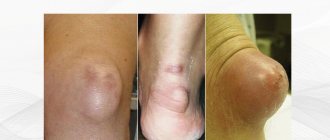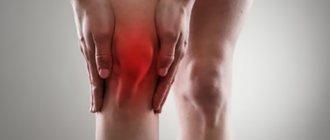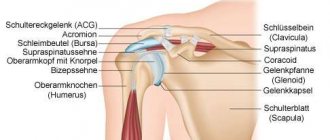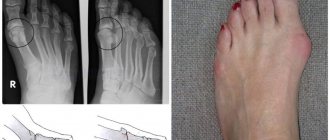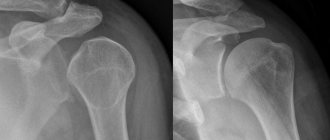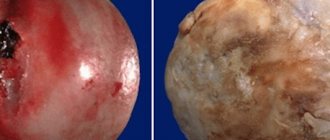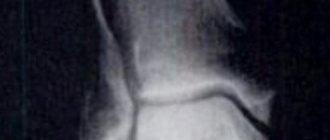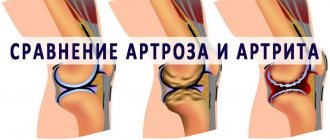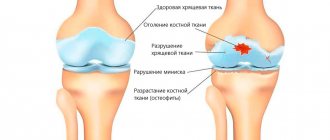Pain in the shoulder joints is a common reason for patients to seek treatment. They arise for several reasons, and if left untreated, they lead to limited abduction in the shoulder joints, after which the person cannot raise his arm above his head. The most common cause of this pain is arthrosis of the shoulder joint. Modern treatment methods make it possible to slow down or even stop the development of degenerative joint diseases and maintain vital activity in patients.
General information
Cartilage tissue is a smooth layer between the adjacent areas of bones. It ensures their easy sliding relative to each other, ensuring free and painless operation of the joint. Excessive stress, inflammation or injury can trigger a degenerative process that gradually spreads over the entire surface.
As a result, the smoothness of the articular surfaces is disrupted, and movements begin to cause pain. At the same time, bone growths begin to appear along the edges of the joint, replacing the affected cartilage. As the degenerative process progresses, it involves not only bones, but also surrounding tissues. The limb becomes deformed, the muscles spasm, and the ligaments become weak and lose elasticity. Without treatment, a person loses the ability to move his arm.
Make an appointment
Causes
Unlike the knee, ankle and hip joints, the shoulder does not experience significant stress when walking, which is why this form of arthrosis occurs much less frequently. Pathology can be caused by:
- regular excessive physical activity: heavy lifting, professional sports, vibration;
- congenital pathologies of the structure of the shoulder joint and adjacent structures;
- rheumatoid arthritis, systemic lupus erythematosus and other autoimmune diseases;
- congenital weakness of connective tissue, accompanied by joint hypermobility;
- injuries: dislocations, sprains and ruptures of ligaments, intra-articular bone fractures;
- hormonal changes and disruptions (including pregnancy, menopause);
- inflammatory diseases of the joint and periarticular structures (arthritis, bursitis, etc.);
- metabolic disorders, including gout, diabetes.
Heredity plays an important role in predisposition to arthrosis.
General clinical recommendations
Persons suffering from shoulder arthrosis are advised to:
- lead a healthy, active lifestyle, alternating physical activity and rest;
- eat properly regularly;
- get rid of all bad habits;
- regularly perform therapeutic exercises, avoiding sudden movements;
- at night sleep on your back or on your healthy side, placing a small pillow under your sore arm;
- avoid heavy physical activity, avoid injuries, prolonged stress and colds;
- in case of exacerbation (development of synovitis), avoid any thermal procedures;
- follow all recommendations of the attending physician.
Prevention
It is especially important for persons with a family history to follow certain rules for the prevention of shoulder arthrosis. They should not engage in weightlifting, tennis, hazardous sports, or work as hammer hammers, blacksmiths, or miners. Anyone who wants to have healthy joints should lead an active lifestyle and eat regularly.
Degrees
Doctors distinguish 3 degrees of deforming arthrosis of the shoulder joint, determining its symptoms and the choice of treatment tactics:
- Grade 1 is characterized by minimal manifestations: pain occurs only during intense or prolonged exercise and quickly goes away after rest, and x-rays reveal subchondral sclerosis of the articular surfaces;
- with arthrosis of the 2nd degree, the pain becomes much stronger, the person has to use painkillers to feel better; The x-ray shows a pronounced narrowing of the joint space, extensive areas of cartilage destruction, as well as bone growths (osteophytes);
- Stage 3 of the disease is accompanied by constant intense pain, joint mobility is significantly limited, and the image shows complete destruction of cartilage tissue, deformation of bone structures and a large number of osteophytes.
Symptoms
Osteoarthritis of the shoulder at the initial stage of development manifests itself only as mild discomfort. Since they occur after hard physical work or being in one body position for a long time, a person attributes them to fatigue. Moreover, the discomfort quickly disappears after rest. But as the shoulder joint is destroyed and deformed, other, pronounced symptoms of osteoarthritis arise:
- in the morning the shoulder swells, swells, looks somewhat larger than healthy;
- after waking up, mobility is limited for 30-40 minutes;
- pain occurs at rest, always intensifies with sudden movement of the shoulder or arm;
- crunching, clicking, and crackling sounds become commonplace, accompanying almost every flexion or extension of the joint.
If soft tissues are injured by osteophytes, an inflammatory process develops. The pain intensifies and stiffness increases. The course of the disease is often complicated by synovitis - acute and then chronic inflammation of the synovial membrane. It is indicated by severe swelling of the shoulder, redness of the skin, and increased local temperature.
Symptoms
The main symptoms of shoulder arthrosis include:
- pain: occurs due to decreased smoothness of articular surfaces, proliferation of osteophytes and bone deformation; the intensity, duration and nature of the sensations depend on the degree of damage;
- crunch: one of the characteristic symptoms of the disease that appears in the early stages; differs from the physiological one in a coarser tone, and is also often accompanied by pain;
- limitation of mobility: associated with the appearance of pathological growths and particles of destroyed cartilage inside the joint; in the first stages it is represented by slight morning stiffness, which later increases until complete immobility (ankylosis);
- deformation: a change in the contours of first only the joint, and then the arm, occurs in the later stages of the disease and indicates complete destruction of the cartilage and involvement of bones, muscles and ligaments in the pathological process.
The progression of symptoms can occur over years or even decades, but eventually arthrosis of the shoulder joint leads to the inability to move the arm and severe pain.
What it is?
Shoulder arthrosis is a long-term, constantly progressive metabolic-dystrophic disease, leading to the gradual destruction of articular cartilage, protective growth of bone tissue with deformation of the joint and loss of its function.
A wide range of arm movements is ensured by the synchronous interaction of the joints of the shoulder complex:
- humeroscapular or simply humeral;
- acromioclavicular - between the collarbone and the acromial process of the scapula;
- sternoclavicular - between the sternum and collarbone.
The shoulder joint is very mobile, which is ensured by the convex head of the humerus and the relatively flat glenoid fossa of the scapula. The joint is strengthened by the tendons of the muscles of the upper limb, and the coracoacromial ligament is located above it. Not too reliable reinforcement allows the joint to move in different directions, but at the same time increases the risk of injury.
The code for shoulder arthrosis according to the International Classification of Diseases, 10th revision (ICD-10) is M19 (other types of arthrosis). Treatment of shoulder arthrosis should begin as early as possible. But advanced stages of the disease can also be successfully treated.
Diagnostics
Diagnosis of arthrosis of the shoulder joint requires an integrated approach. To accurately make a diagnosis and determine the extent of damage, the doctor uses the following methods:
- interview and history taking: the patient’s complaints are recorded, the circumstances of the occurrence of certain symptoms are determined; It is mandatory to clarify information about previous diseases and injuries, and the presence of joint damage in parents;
- examination: the doctor evaluates the joint visually, determines the range of movements, the area of greatest pain, etc.;
- X-ray and CT: the main diagnostic method that allows you to see the characteristic symptoms of osteoarthritis (narrowing of the joint space, cartilage degeneration, bone growths and deformities);
- Ultrasound: makes it possible to assess the condition of cartilage, bones, ligaments, joint capsule and muscles;
- MRI: allows you to obtain virtual sections of all structures of the affected area;
- laboratory diagnostics: a blood test reveals an active inflammatory process, often accompanying arthrosis;
- arthroscopy: examining the inside of a joint using a camera inserted through a small puncture.
If the disease is secondary in nature, examinations and consultations with narrow specialists on the underlying pathology are mandatory.
Treatment of arthrosis of the shoulder joint
Treatment of arthrosis of the shoulder joint depends on the degree of damage: at stages 1 and 2, the disease can be successfully stopped or slowed down by the correct selection of drugs. In case of extensive destruction, the only way to restore mobility and completely stop pain is surgery - arthroscopy with “cleaning” of the joint.
Drug treatment
Drug treatment for shoulder arthrosis is aimed at reducing symptoms and restoring cartilage tissue. The following groups of drugs are used for this:
- non-steroidal anti-inflammatory drugs (diclofenac, ibuprofen, nimesulide, meloxicam and their derivatives): block inflammatory reactions and reduce pain; are available in the form of tablets, ointments, suppositories and in injection form;
- hormonal agents (corticosteroids): used when NSAIDs are ineffective, have a similar effect; long-acting drugs injected directly into the joint cavity have a good effect;
- antispasmodics, B vitamins: used to reduce muscle spasms that inevitably accompany advanced arthrosis;
- chondroprotectors (chondroitin, glucosamine and their combinations): intended for long-term use, aimed at restoring cartilage tissue;
- drugs that improve microcirculation (nicotinic acid, pentoxifylline and others): indirectly stimulate regeneration processes by improving blood supply to the affected area;
- Enzyme blockers (contrical, gordox): partially slow down the destruction of cartilage tissue.
The selection of specific drugs, their dose, frequency of administration and course duration is carried out only by a doctor! It is important to remember that self-medication can accelerate joint degeneration and cause other side effects.
Physiotherapy
Physiotherapeutic techniques and exercise therapy significantly alleviate the course of the disease and enhance the effect of medications. The following procedures have proven good results:
- magnetic therapy: relieves pain, relieves inflammation, improves microcirculation and stimulates the regeneration of cartilage tissue;
- shock wave therapy: exposure to acoustic waves of a certain frequency helps destroy osteophytes, which facilitates movement in the affected joint;
- electrophoresis, phonophoresis: introduction of medications (painkillers, chondroprotectors) into tissues using electrical impulses or ultrasound; promotes better absorption of drugs;
- massage and physical therapy: dosed loads on the joint and intense manual stimulation stimulate blood circulation in the tissues.
Like medications, physiotherapy, massage and exercise therapy should be prescribed and carried out under the supervision of a specialist. If they are beneficial during a calm period, then exposure against the background of an acute inflammatory process can cause increased pain.
Surgery
The last stage of shoulder arthrosis is accompanied by severe symptoms and requires surgical treatment. Most of the changes that occur as a result of degeneration are irreversible, which is why the only way to restore mobility to a person is endoprosthetics. The affected joint is replaced with a modern prosthesis, which completely takes over its functions. This operation is especially effective in young and middle age, as it allows you to live without pain for years.
Make an appointment
Diet
For shoulder arthrosis of any degree, it is important to monitor your diet:
- avoid overeating and excess weight;
- minimize harmful foods: fatty, spicy, salty, alcohol, canned food, smoked foods;
- consume a sufficient amount of foods high in collagen (jelly, aspic) and omega-3 (fatty fish, olive oils);
- give preference to boiled, steamed or stewed food rather than fried foods;
- reduce the amount of quickly digestible carbohydrates.
The diet should be complete and include the required amount of vitamins, minerals and nutrients.
Frequently asked questions about the disease
What is the pain with shoulder arthrosis?
The pain is aching and worsens with movement and lifting weights.
How dangerous is the disease?
Formation of constant pain syndrome and loss of limb function.
Which doctor treats deforming arthrosis of the shoulder?
Post-traumatic - orthopedist-traumatologist, against the background of inflammatory diseases - rheumatologist.
Is a blockade done for shoulder arthrosis?
For severe pain - yes.
How effective are physiotherapeutic methods for this disease?
Effective as part of complex treatment.
Is it possible to completely cure deforming arthrosis of the shoulder?
No, but the doctor will be able to suppress its progression and relieve the patient of pain.
Shoulder arthrosis must be treated long-term, systematically and strictly under the supervision of a doctor. Attempts to cope with this disease on your own are fraught with complications and disability. But a qualified specialist can stop the process at any stage of the disease, relieve the patient of pain and significantly improve his quality of life. Contact the Moscow clinic “Paramita”, they will definitely help you here!
Literature:
- Zagorodniy N.V. Intra-articular and periarticular therapy of diseases of the musculoskeletal system: Educational method. allowance. M. 2002. 48 p.
- Filipenko P.V., Prokhorenko V.M., Fomenko S.M. Historical review and trends in the development of surgical treatment of chronic instability of the shoulder joint // Siberian Scientific Medical Journal, 2015, v. 35, no. 3, pp. 37-45
- Bottoni CR, Franks BR, Moore JH, DeBerardino TM, Taylor DC, Arciero RA. Operative stabilization of posterior shoulder instability.// Am J Sports Med. July 2005; 33(7):996-1002.
- Nelson AE, Allen KD, Golightly YM, et al. A systematic review of recommendations and guidelines for the management of osteoarthritis: The chronic osteoarthritis management initiative of the US bone and joint initiative // Semin Arthritis Rheum. 2014 Jun. No. 43(6). P. 701-12. Doi: 10.1016/j.semarthrit.2013.11.012. Epub 2013 Dec 4.
Themes
Arthrosis, Joints, Pain, Treatment without surgery Date of publication: 03.11.2021 Date of update: 03.11.2021
Reader rating
Rating: 5 / 5 (1)
Consequences and complications
Even a slight pain and crunch in the shoulder can result in unpleasant consequences. Without treatment, arthrosis leads to:
- significant restriction of mobility up to ankylosis (fusion of bones with each other);
- severe pain even at rest;
- severe deformation of the shoulder and entire arm.
To avoid these problems, it is important not to search on the Internet for how to treat arthrosis of the shoulder joint with folk remedies, but simply contact an orthopedist to select therapy.
Physiotherapy
Therapeutic exercise is an integral part of complex treatment. Consider simple exercises for treating the shoulder joint:
- Stand straight, slowly raise your shoulders while inhaling gradually, and then lower them while exhaling slowly.
- Squeeze your shoulder blades in and out, moving your shoulders forward and back.
- Continuing to stand straight, you need to spread your elbows to the sides, pressing your fingertips to your shoulders. Make circular movements clockwise and then counterclockwise.
- This exercise duplicates the previous one, only your arms should be straight when performing it.
- Sitting on a chair, clasping your sore wrist with your healthy hand, you need to lightly pull it, without making sudden movements or jerks.
- Lying on your back, we raise our arms, crossing the fingers of both hands, interlocking them, and gradually moving them behind our heads.
- Sitting on a chair, straighten your back, take 0.5 or 1 kg dumbbells in your hands (if you don’t have dumbbells, you can use ordinary plastic bottles filled with water, 0.5 and 1 liter in volume, respectively), raise your arms and rotate them forward and back.
Options for performing exercises
All these exercises take no more than 15 minutes a day, but the effect is enormous. Already from the second week of daily practice, a visible effect occurs. A set of exercises should be used until remission occurs. But a doctor must draw it up; if you choose it yourself, then a doctor’s consultation is still necessary.
Treatment at the Energy of Health clinic
Orthopedists at the Energy of Health clinic offer patients comprehensive treatment methods for shoulder arthrosis:
- modern drug therapy regimens that combine high efficiency and minimal side effects;
- time-tested and new physiotherapeutic techniques;
- PRP therapy;
- physical therapy and massage to relieve restrictions on joint movements.
If necessary, therapeutic punctures of the joint are performed with the administration of painkillers or artificial synovial fluid to facilitate movement.
We monitor the patient throughout the treatment to keep the disease under control.
Folk remedies
The treatment of arthrosis with folk remedies must be approached in a balanced, rational manner, without relying entirely on information gleaned from dubious newspapers about a healthy lifestyle and conversations with neighbors. Blindly following incompetent, unscientific recommendations, no matter how convincing and categorical they are expressed, can only do harm, contributing to the transition of the disease to a more advanced stage. And advanced arthrosis will then be very difficult to treat “from scratch”. Therefore, before starting to use this or that folk remedy, you should consult your doctor. Here we will also list several medicinal plants, the use of which for deforming osteoarthritis has stood the test of time and has repeatedly proven its effectiveness:
- White cabbage;
- Birch buds;
- St. John's wort;
- corn silk;
- burdock (large, small, felt);
- field dandelion;
- black radish;
- horseradish;
- creeping thyme.
These plants and their parts are used in a wide variety of forms (decoctions, infusions, lotions, ointments). The dose and duration of use is determined individually, experimentally. Treatment begins with minimal doses. In case of a weak therapeutic response, provided the treatment is well tolerated, the dose can be increased. It is not recommended to use a preparation from one plant for more than a month. It is necessary to periodically consult a doctor to monitor the results of treatment.
Advantages of the clinic
The Health Energy Clinic offers its patients:
- comprehensive health screening programs;
- extensive examinations for an accurate diagnosis;
- consultations with narrow specialists of various profiles;
- modern treatment regimens, including not only medications, but also physiotherapy, massage and exercise therapy;
- affordable prices for all services.
Arthrosis of the shoulder joint is a problem that can completely change a person’s life. Don’t let the disease reach an irreversible stage, come for a consultation with an orthopedist at Energy of Health.
Detection of pathology
The most informative method for osteoarthritis of the shoulder joint is radiography. Based on characteristic radiographic signs, it is possible to identify not only the disease itself, but also its stage and features of the course. If tissue inflammation is suspected, as well as for a more detailed study of the condition of the joint, MRI and CT are performed. Performing arthroscopy allows for targeted collection of biological samples:
- cartilage;
- synovial membrane;
- joint fluid.
Carrying out biochemical studies and morphological study of biopsy samples helps to assess degenerative changes in the structures of the shoulder joint.

